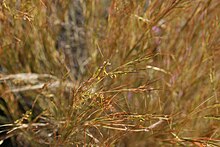Aegilops: Difference between revisions
Appearance
Content deleted Content added
m Bot: Migrating 15 interwiki links, now provided by Wikidata on d:q1764888 (Report Errors) |
|||
| Line 53: | Line 53: | ||
==External links== |
==External links== |
||
*[http:// |
*[http://www.cwrdiversity.org/checklist/genepool-details.php?id%5b%5d=22&id%5b%5d=4184&id%5b%5d=578& Crop Wild Relatives Inventory] reliable information source on where and what to conserve ''ex-situ'', regarding ''Aegilops'' genepool |
||
*[http://ucjeps.berkeley.edu/cgi-bin/get_JM_treatment.pl?8738,8760 Jepson Manual Treatment] |
*[http://ucjeps.berkeley.edu/cgi-bin/get_JM_treatment.pl?8738,8760 Jepson Manual Treatment] |
||
*[http://plants.usda.gov/java/profile?symbol=AEGIL USDA Plants Profile] |
*[http://plants.usda.gov/java/profile?symbol=AEGIL USDA Plants Profile] |
||
Revision as of 20:19, 11 September 2013
| Aegilops | |
|---|---|

| |
| Aegilops speltoides | |
| Scientific classification | |
| Kingdom: | |
| (unranked): | |
| (unranked): | |
| (unranked): | |
| Order: | |
| Family: | |
| Genus: | Aegilops |
| Species | |
|
About 27, See text. | |
Aegilops is a genus of plants generally known as goatgrasses and belonging to the grass family, Poaceae.[1] There are about 23 species and numerous sub species in the genus. Various members of the genus are classed as agricultural weeds. Growing through the winter, they resemble winter wheat. They are able to hybridize with various types of wheat and are sometimes classified as members of the wheat genus, Triticum.
Aegilops tauschii (also known as Aegilops squarrosa) is important in wheat genetics as a parent of common wheat, Triticum aestivum.
The word Aegilops is notable for having all eight letters in alphabetical order.
Selected species:
- Aegilops bicornis
- Aegilops biuncialis
- Aegilops caudata
- Aegilops columnaris
- Aegilops comosa
- Aegilops crassa - Persian goatgrass
- Aegilops cylindrica - Jointed goatgrass
- Aegilops geniculata
- Aegilops juvenalis
- Aegilops kotschyi - Ovate goatgrass
- Aegilops longissima
- Aegilops lorentii - Lorent's goatgrass
- Aegilops mutica
- Aegilops neglecta - Three-awned goatgrass
- Aegilops peregrina
- Aegilops searsii - Sears' goatgrass
- Aegilops sharonensis
- Aegilops speltoides
- Aegilops tauschii - Tausch's goatgrass
- Aegilops triuncialis - Barbed goatgrass
- Aegilops umbellulata
- Aegilops uniaristata
- Aegilops vavilovii
- Aegilops ventricosa
See also
References
- ^ Watson L, Dallwitz MJ. (2008). "The grass genera of the world: descriptions, illustrations, identification, and information retrieval; including synonyms, morphology, anatomy, physiology, phytochemistry, cytology, classification, pathogens, world and local distribution, and references". The Grass Genera of the World. Retrieved 2009-08-19.
External links
- Crop Wild Relatives Inventory reliable information source on where and what to conserve ex-situ, regarding Aegilops genepool
- Jepson Manual Treatment
- USDA Plants Profile
- Grass Manual Genus Treatment
